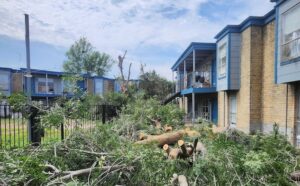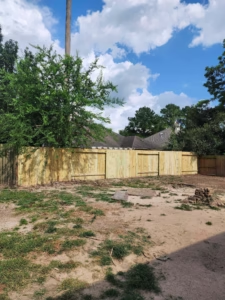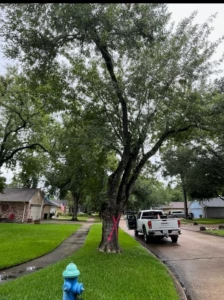Wildfires are a growing concern, especially in areas like California, where dry conditions, high temperatures, and dense vegetation create the perfect environment for fires to spread rapidly. While trees are a vital part of our ecosystem, they can also become significant fire hazards if not properly managed. If you’re wondering whether your trees pose a risk and what you can do to mitigate that risk, this guide is for you. We’ll walk you through how to assess your trees, reduce fire hazards, and protect your property.
Why Trees Can Become Fire Hazards?
Trees can contribute to the spread of wildfires due to the following factors:
- Deadwood and Debris: Dead branches, dry leaves, and other debris act as fuel for fires.
- Proximity to Structures: Trees that are too close to homes, fences, or power lines can transfer flames to structures.
- Overgrown or Dense Foliage: Dense canopies and untrimmed branches allow fire to move from one tree to another or from ground vegetation to tree tops (known as a “crown fire”).
- Flammable Species: Certain tree species, such as pine, eucalyptus, and juniper, contain oils or resins that make them more flammable.
How to Assess If Your Trees Are a Fire Hazard?
1. Inspect the Canopy
- Look for overgrown branches that touch your roof, siding, or power lines.
- Ensure there is at least a 10-foot clearance between trees and any structures.
- Check for dead or dying branches, as these are highly combustible.
2. Examine the Base of the Tree
- Clear any accumulated dry leaves, twigs, or bark at the tree’s base.
- Ensure there is no flammable vegetation like shrubs or grasses near the tree trunk.
3. Check the Tree’s Health
- Dead or diseased trees are more likely to catch fire and fall, causing damage.
- Signs of poor health include:
- Cracked or peeling bark.
- Discolored or sparse foliage.
- Visible infestations or fungal growth.
4. Evaluate Tree Spacing
- Trees should be spaced to prevent fire from jumping between them.
- For most areas, a spacing of at least 10 feet between canopies is recommended.
5. Consider the Species
- Identify the tree species on your property. Flammable trees like pine, eucalyptus, and juniper should be managed with extra care.
- Opt for fire-resistant trees, such as oak, maple, and certain types of ash, in future landscaping.
How to Act: Steps to Reduce Fire Hazards
1. Prune and Trim Regularly
- Remove dead branches and thin out dense foliage.
- Keep branches at least 10 feet away from chimneys and power lines.
2. Maintain a Defensible Space
- Create a buffer zone of at least 30 feet around your home where vegetation is well-maintained and less flammable.
- Extend this space up to 100 feet in wildfire-prone areas.
3. Remove Dead or Hazardous Trees
- Dead trees should be removed as soon as possible.
- Contact a professional arborist for safe removal, especially for large or precariously positioned trees.
4. Clear Ground Debris
- Regularly rake and remove leaves, twigs, and other flammable materials.
- Apply mulch made from non-flammable materials, such as gravel, near tree bases.
5. Choose Fire-Resistant Trees for Landscaping
- Replace highly flammable trees with fire-resistant species.
- Opt for native plants that require less water and are adapted to local conditions.
6. Stay Compliant with Local Regulations
- Check with local fire departments or city ordinances for tree management guidelines.
- Obtain any necessary permits before removing trees or making significant changes to your landscaping.
Fire Hazard Tree Management: When to Call a Professional
While some tasks, such as clearing debris and minor pruning, can be done yourself, others require professional expertise:
- Tree Removal: Large or dead trees near structures should only be removed by certified arborists.
- Hazard Assessment: Professionals can provide a detailed risk assessment of your property.
- Emergency Services: After a wildfire, damaged trees may need immediate attention to prevent further hazards.
Final Thoughts
As wildfires become more frequent and intense, proactive tree management is essential for protecting your property and community. Regular inspections, pruning, and the removal of hazardous trees can significantly reduce fire risks. By following these steps and consulting professionals when needed, you can ensure that your trees remain an asset rather than a liability during wildfire season.
Contact HamodaTrees Today
If you’re concerned about your trees and want a professional evaluation, HamodaTrees is here to help. Our team of certified arborists can provide risk assessments, tree care, and emergency services tailored to your needs. Contact us today to schedule a consultation!




